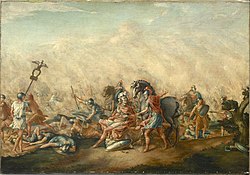Lucius Aemilius Paullus | |
|---|---|
 The Death of Paulus Aemilius at the Battle of Cannae by John Trumbull | |
| Roman consul | |
| In office 15 March 216 BC –2 August 216 BC Servingwith Gaius Terentius Varro | |
| Preceded by | Gnaeus Servilius Geminus Marcus Atilius Regulus |
| Succeeded by | Gaius Terentius Varro (remaining term) |
| In office 15 March 219 BC –14 March 218 BC Servingwith Marcus Livius Salinator | |
| Preceded by | Gaius Lutatius Catulus Lucius Veturius Philo |
| Succeeded by | Publius Cornelius Scipio Tiberius Sempronius Longus |
| Personal details | |
| Died | 2 August 216 BC Cannae,Roman Republic |
| Cause of death | Killed in action (Arrow) |
| Nationality | Roman |
| Children | Lucius Aemilius Paullus Macedonicus Aemilia Prima Aemilia Secunda Aemilia Tertia |
| Military service | |
| Allegiance | Roman Republic |
| Battles/wars | |
Lucius Aemilius Paullus (died 2 August 216 BC), also spelled Paulus, was a consul of the Roman Republic twice, in 219 and 216 BC. He is primarily remembered for being one of the commanders of the Roman army at the Battle of Cannae, and for his death in the same battle.